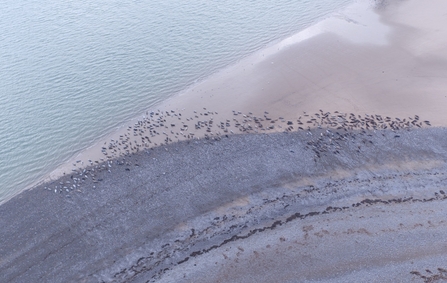
The drone counted record numbers of seals at South Walney Nature Reserve this spring © Cumbria Wildlife Trust
Join by 30 January to get 3 months free membership!

The drone counted record numbers of seals at South Walney Nature Reserve this spring © Cumbria Wildlife Trust
We've counted a record number of grey seals at South Walney Nature Reserve, thanks to the latest drone technology. Our recent drone survey counted 518 seals. The previous highest survey recorded 483 seals (March 2019), and prior to that, 360 was the highest count (January 2018).
Dr Emily Baxter, Senior Marine Conservation Officer at Cumbria Wildlife Trust said: “This is very exciting news and is a five-fold increase in the population of grey seals during the nine years that I’ve been with the Trust. We’re lucky enough to have Cumbria’s only grey seal colony here at South Walney Nature Reserve and in fact this is the only place that seals haul out in large numbers in the whole of the North West! It’s a precious colony that has grown rapidly over the last 10 years.”
Dr Baxter explains how the grey seal population is counted: “We take great care using a drone, which flies very high and requires special permission from Natural England, to avoid distressing the seals and other wildlife. We’ve been using this exciting new technology to survey the seals for the past few years. It’s a great resource for us to use, although we’re continuing with our traditional counts, which involve us crawling across the shingle and watching the seals through binoculars, to compare results. Both methods are important, but the drone gives us more accurate numbers.”
Seal surveys are carried out fortnightly at South Walney Nature Reserve, from September to March. Some drone surveys are also done in the summer, to contribute to the UK seal census in August. The surveys monitor the seal population structure in the area from year to year. The behaviours displayed by the seals are also monitored to gain an understanding of how they respond to different factors. This includes how they are affected by human disturbance, such as boating and recreational use of the sea surrounding Walney Island.
Dr Baxter says the fact that the seal colony is thriving is not down to luck but thanks to the protective measures that we've put in place: “Staff and volunteers at South Walney Nature Reserve have worked really hard to make sure the colony of grey seals is protected from disturbance from people and dogs, as the beaches are closed to the public. However during lockdown there were a number of incidents with people landing kayaks onto the protected beaches. This caused a significant amount of disturbance, including putting flocks of thousands of waders into the air and scaring the seals away. When seals are disturbed, they flee into the sea using up important energy stores.”
The best way to enjoy the grey seals is to watch our live streaming seal cam.
If you wish to visit the nature reserve, please note that the beaches where the seals haul up are not open to the public. You can see the seals from a safe distance, from one of the hides at South Walney. They can be seen playing in the water at high tide, along with thousands of wildfowl and wading birds. Braithwaite Hide, where the seals can usually be viewed from, is currently closed but we've put up a screened viewing point next to it, to allow people to get a better view of seals in the water, without disturbing wildlife.
Also this is nesting season for ground-nesting birds at South Walney and it’s crucial that any visitors keep to the footpaths and don’t bring dogs on to the nature reserve (only registered assistance dogs are allowed).
Please note that in line with Government guidance, the hides and visitor centre at South Walney Nature Reserve are closed until further notice, but the car park and toilets are open. If you are visiting the nature reserve, please follow social distancing guidelines.
Please note that drone filming is not allowed by members of the public at South Walney Nature Reserve.